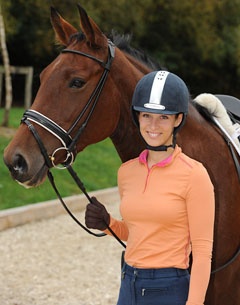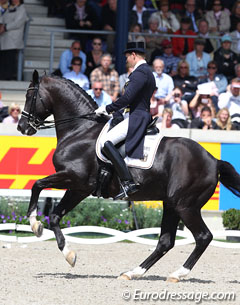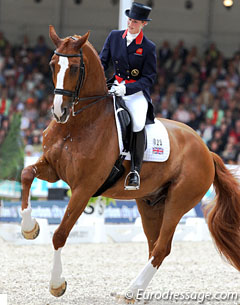
Our Guest Columnist of the Week is Alice Collins, Horse & Hound Dressage and Sport Horse Editor. Collins in the Dressage and Sport Horse Editor of Horse & Hound magazine in the UK.
A rider, breeder and equine AI technician herself, she has worked in equestrian media for four years after spending five years training with various dressage riders and gaining teaching qualifications in the industry.
Dressage Dilemmas
Presentations at the recent Global Dressage Forum (GDF) in Holland got me thinking about what exactly it is that makes exquisite dressage.
It’s all very well for riders to aspire to stick as closely as possible to the rules. We all know the tricks — let the piaffe travel forward for a horse who struggles coming out of it; collect the trot more in the corner before the extension for a horse whose extended paces aren’t all that hot... But what about knowingly contravening guidelines? And what if that’s rewarded with a 10?
Let’s take the pirouettes. The judging guidelines on the FEI’s website have, among other things, the following to say about them:
Definition: The horse, slightly bent in the direction in which it is turning, remains “on the bit” with light contact, turning smoothly around, and maintaining sequence and timing of footfalls of that pace.
Rhythm: Rhythm should be clear, steady and in a genuine three beat before, after and during the pirouette.
Collection: The horse bends the haunches, flexes the hind leg joints and really takes weight behind. Lowering of the croup and clear self-carriage.
Execution: The outside hind foot should engage and track forward under the body of the horse without any deviation to the outside. The inside hind leg and outside front leg are not touching the ground simultaneously.
Guidelines: For top marks of 9 or 10 the pirouette must be almost on the spot.
In the pirouette the rhythm appears to be a three beat although with small pirouettes this is almost impossible. There is much theoretical discussion based on slow motion recordings but this should not cloud the judge’s assessment. There may be a slight hesitation but the canter gives the impression of a clear beat.
Clear? Well, no. The guidelines are about as clear as the FEI’s muddy statutes that landed it in a tribunal, courtesy of the IDRC.
 The outcome of that hearing stated that: “The two interpretations [of the FEI statutes] cannot co-exist and therefore the FEI Tribunal must decide which is correct.”
The outcome of that hearing stated that: “The two interpretations [of the FEI statutes] cannot co-exist and therefore the FEI Tribunal must decide which is correct.”
Perhaps we’ve reached the point with pirouettes where someone needs to be asking questions about what is truly right.
Pretty much every picture of a pirouette you’ll see, from bog-standard national level all the way up to the Olympics, will depict the horse on both its hind legs with the forehand elevated. But isn’t elevation of the forehand the holy grail of a quality dressage horse? We’ve all seen test sheets where judges have commented that the horse needs more elevation of the forehand. Surely these four-time pirouettes where the horse is sitting in an extreme way show the culmination of decades of careful breeding to make our equine athletes as uphill as possible? So perhaps they should be rewarded with a 10. But, wait, it’s the (three-time) canter we’re assessing (or isn’t it?), as the pirouette is performed at canter.
If we can tell that the canter is not a true three-beat gait in the pirouette, then surely it’s not an eligible candidate for a 10? So what is a rider to do? Aim for what the guidelines suggest and do their utmost to maintain a three-beat canter, or collect the canter, allow the horse to come into a four-beat canter to enable the smallest pirouette possible?
Let’s spare a thought for the judges here as they must essentially assess two things at the same time which cannot co-exist. It sure is a toughie and I’ll bet we haven’t heard the last about it.
Canter in chaos?
But the confusion doesn’t end there. The American grand prix rider and a pioneer in equine biomechanics Hilary Clayton gave a presentation at the GDF about the canter and how it changes according to level of training.
If canter is defined as a three beat gait with a moment of suspension, what happens if there is deviation from that? Is it a hanging offence or can horses still gain high marks — 10s even?
Hilary ascertained that young horses perceived as having good canters tend to show “hind-first dissociation” — where the diagonal pair in the canter is split, with the hind foot landing first.
With the effects of training, this can change. Often grand prix horses show front-first dissociation. This comes about with the increased degree of collection as the horse brings its front leg more underneath itself in order to maintain the collected frame with the higher wither and neck position.
 She then showed two videos of horses with unusual canters. Both looked incorrect when played at normal speed and the audience agreed that both appeared four-beat. When the videos were slowed, it was clear that one horse’s canter was three-beat, but had no moment of suspension. The other had a huge diagonal disassociation.
She then showed two videos of horses with unusual canters. Both looked incorrect when played at normal speed and the audience agreed that both appeared four-beat. When the videos were slowed, it was clear that one horse’s canter was three-beat, but had no moment of suspension. The other had a huge diagonal disassociation.
Canter is a mighty hard pace to assess — probably the most difficult of the three we need to worry about in dressage. Apart from the select few experts capable of properly assessing canters, most people aren’t really sure what they’re seeing, and have learnt to use the term ‘four-time’ to describe something that’s not visually pleasing, regardless of the actual problem. The rule of thumb is: if in doubt, say it’s four-time and we won’t look silly in front of our friends.
So is it a question of better educating our eyes?
With the collection and uphill tendency required in the modern-day dressage horse, it is perhaps no wonder that we might have altered the mechanics of nature. But does it matter? Is dressage evolving positively and should we embrace this change along with the shape and movement of our equine partners? Or are we breeding and rewarding horses who are perhaps not physically capable of the job of top-level dressage?
I’m well aware that there are far more questions than answers here. But I hope that they at least spark debate about what it really is that makes dressage so magnificent and what truly deserves that oh-so-elusive 10.
By Alice Collins, Horse & Hound Dressage and Sport Horse Editor